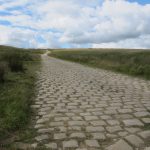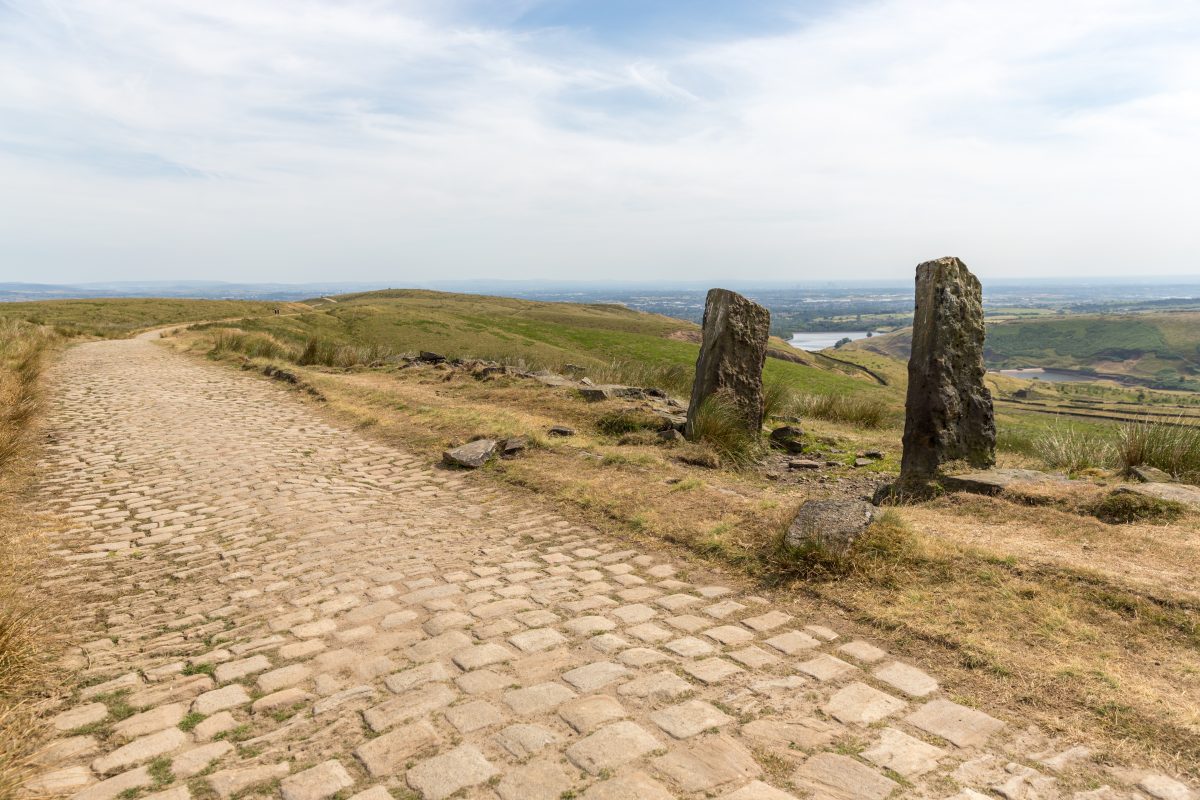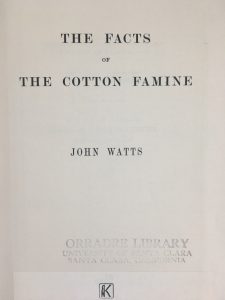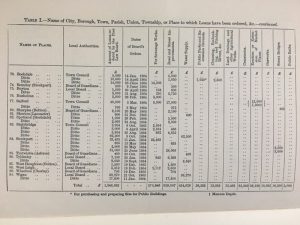The ‘Cotton Famine Road’ section of Rooley Moor Road could be of National and International importance, it is a reminder of the harsh times cotton workers had to endure during the Cotton Famine and is unique in linking the American Civil War to social changes in our own country at a time when the Rochdale Pioneer Movement influenced social thinking throughout the UK.
Sections of the Cotton Famine Road consist of stone setts, which were hewn by hammer and chisel from local quarries. The approximate length of these sections, from Ding Quarry entrance to Catley Lane Head, is 1,950 yards, the number of stone setts across the road varies from 12 along the narrow sections to 24 at Catley Lane Head. Presuming an average number of stone setts per row of 16 and rows per yard of 10.5 gives a total number of 327,600 stone setts, this excludes the volume of the stone edgings and drainage channels.
Given the poor of Rochdale laid about a third of a million stone setts into the fabric of Rooley Moor by hand, the Cotton Famine Road has to be worthy of preservation!
At an altitude of over 1500 feet this historic feature may also lay claim to being one of the highest roads in England. Enjoyed by walkers & runners, ornithologists and cyclists, this moorland route also forms part of the Pennine Bridleway allowing safe access for horse riders on the Mary Townley Loop.
The upper section of Rooley Moor Road is visible from many miles away (often called the ‘yellow brick road’) and is a prominent part of the North Manchester / Lancashire / West Yorkshire landscape.
We think many people who see the road from afar do not currently appreciate its history or significance, and an underlying objective of the neighbourhood forum will be to improve this awareness.
Audio
Our thanks to Mid Pennines Arts for letting us this audio description of the section of Rooley Moor Road known locally as the Cotton Famine Road.
Video
The Cotton Famine Road
Thanks go to the Manor of Rochdale for giving permission to film and drive on the moor.
Food Aid
Our thanks go to the BBC and David Olusoga for letting us use these video clips.
History
“The first official mention of the road was in 1729, when Godman quotes the Lancashire Quarter Session as recording:
‘The Court doth enlarge the time to the inhabitants of Catley Lane for the repairs of the highway in Spotland from Spotland Bridge to Gorse Hill Leach ‘till the Midsummer sessions.*’
University of Manchester Archaeological Unit surmises that this referred to the stretch of Rooley Moor Road from Spodden Brook, 2km to the south-east of Catley Lane Head, to the area currently known as ‘Top of Leach’ near the highest point of the moor. Like many roads at the time, the upkeep of Rooley Moor Road fell to the local inhabitants of the area who had to supply all materials and labour. The Lancashire County Quarter Sessions records local people being required to pay a levy for maintenance of Woodhouse Lane by 1746** and Rooley Moor Road again in 1767***.
*University of Manchester Archaeological Unit. Desk-Based Assessment Rooley Moor Road (Manchester, UMAU, 2003), 6 and Godman, P. ‘Cotton Road or Not – This History Deserves Some Recognition’, Rochdale Observer, 14.10.1995, 20
**Lancashire Archives, ref. QSP/1582/20
***Lancashire Archives, ref. QSP/1906/41
“Lancashire mill workers sent a letter of support to Abraham Lincoln in 1862 and he replied personally, acknowledging the hardships the people had had to suffer. Local councils including Rochdale organised their own ‘Cotton Famine Relief Funds’ to alleviate the suffering of unemployed mill workers. By March 1863, ‘outdoor relief’ was being given to 19,374 people and, with many other workers on short time, local action was not enough. Later that year, the Public Works (Manufacturing Districts) Act was passed allowing the town’s Board of Guardians to borrow money at a low-interest rate to create projects in areas of high unemployment. One such project was for ‘improvements to Catley Lane’ for which £500 was borrowed****; this may be where the local styling of the ‘Cotton Famine Road’ originated. In February 1864, the Board of Guardians had hoped to borrow twice that amount and construction work was interrupted but had re-started by May with 25 men employed at Catley Lane and at another project to build a workhouse at Marland.”
****Anon. A Brief History of Rooley Moor Road [nd]. Held at Touchstones Local Studies Library and Godman, P. ‘Cotton Road or Not – This History Deserves Some Recognition’, Rochdale Observer, 14.10.1995, 20.
The ordnance survey map published in 1851 (https://maps.nls.uk/view/102344003) shows Catley Lane finished at the junction with Smallshaw Road, at which point Rooley Moor Road commenced in a northerly direction.
Timeline
The following is taken from The Annals of Rochdale By R. D. Mattley
1862
- January 13 – Relief Committee formed, to meet the distress owing to the American War.
- February 5 – Soup Kitchen opened. Down to 22nd January, 1863, the Relief Committee received £26,697 18s. 5d. for distribution among the unemployed.
- May 15 – Cotton Famine; 3,879 cotton operatives wholly out of employment: 2,861 on short time.
- July 12 – Wages of over 6,000 operatives did not average 1s. 6d. each weekly owing to trade depression.
- August 22 – 8,000 Operatives met on Lobden Moor to consider the distressed condition of the district.
- October 30 – Mr. Cobden visited the Sewing Classes to relieve the distressed, held at St.Chads, St. James and Holland Street Schools.
- December 13 – 18,000 persons were relieved by the Soup Kitchen during the week ended this day; in addition the Guardians relieved 13,226.
1863
- February 3 – Town’s Meeting adopted a resolution thanking the Citizens of New York for their sympathy during the Cotton Famine. John Bright spoke.
- February 28 – “Alabama” the Confederate Cruiser, carried on board in several engagements a Rochdale youth named Bell.
- May 9 – Government Inquiry held as to the best mode of employing the adult able-bodied men out of work by reason of the distress
- September 29 – £39,446 distributed by the Guardians in Poor Relief for the year ended this day – a record.
- November 25 – 8,359 Persons estimated to be out of work in consequence of the American Civil War.
- December 2 – The “Southern Independence” Club essayed a Lecture in the Public Hall in favour of the Southern States. A great crowd attended. Supporters of the Northern Programme ultimately got control of the hall and severely handled the lecturer.
1865
- May 4 – Town’s Meeting to express indignation at the Assassination of President Lincoln.
1866
- February 5 – Final meeting of the Relief Committee. One million sterling estimated to have been lost in wages through the depression.
- The following reference was published in 1866:
Note loans for, “Road and Street Improvements” (thanks to Sam Schofield at Historic England for supplying this information):
- Line 73 Rochdale (Town Council) 14 Jan 1864 £5,000 and 14 April 1864 £1,050.
- Line 82 Spotland (Board of Guardians) 29 Feb 1864 £1,000 and 24 Aug 1864 £2,000.
See also
Bank of England – Inflation Calculator – To see what the values above would be worth today!
Lincoln’s Letter to the Working-Men of Manchester, England
Source: The American Civil War Society
New York Times – Nov. 18, 1862: The speech of Mr. Cobden at Rochdale
The Cotton Famine Window, North Manchester General Hospital.

Related Documents
RMR archaelogical assessment June 2003
Rooley Moor Road - An Archaeological Desk-Based Assessment - June 2003
Related Images









